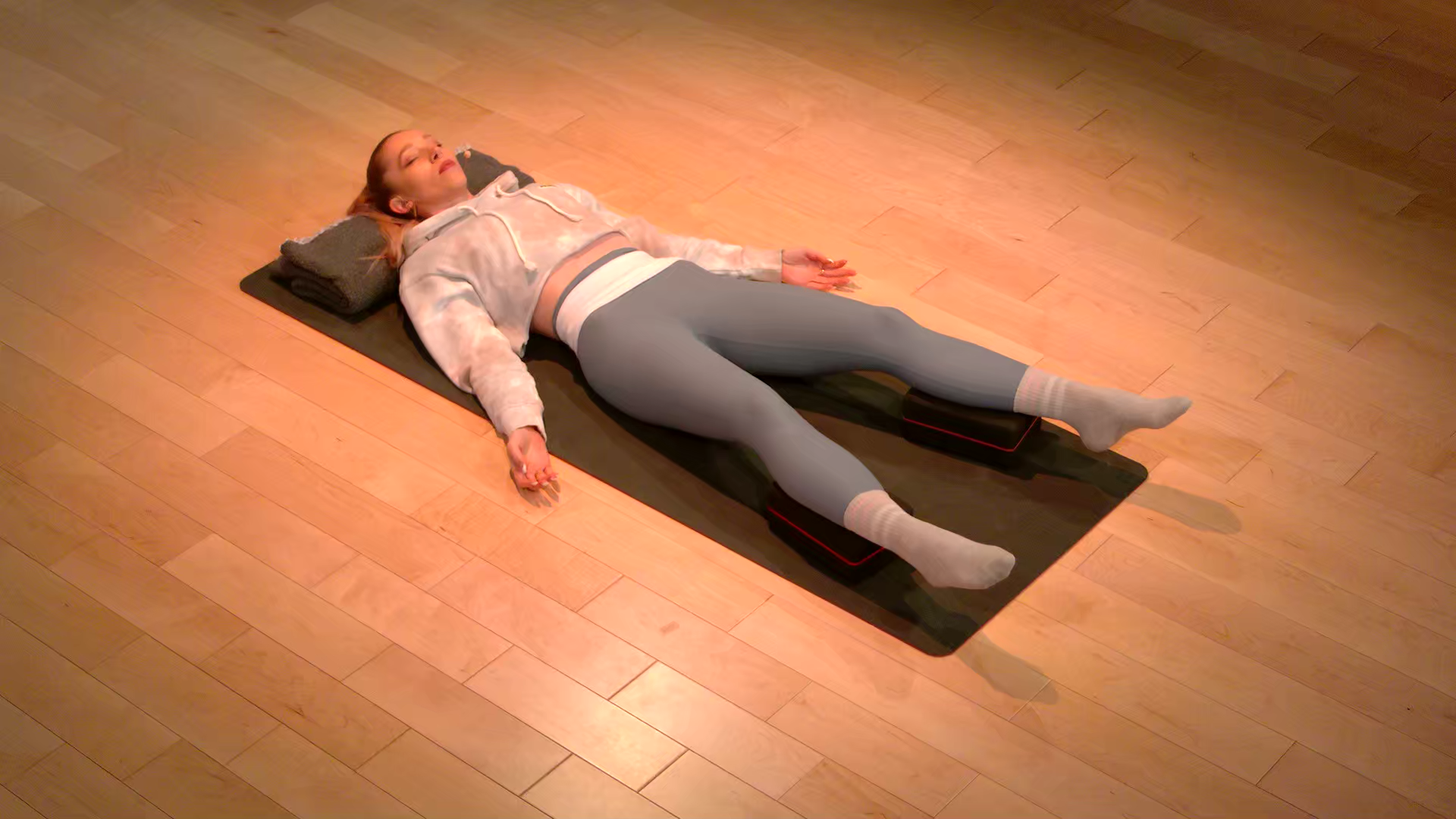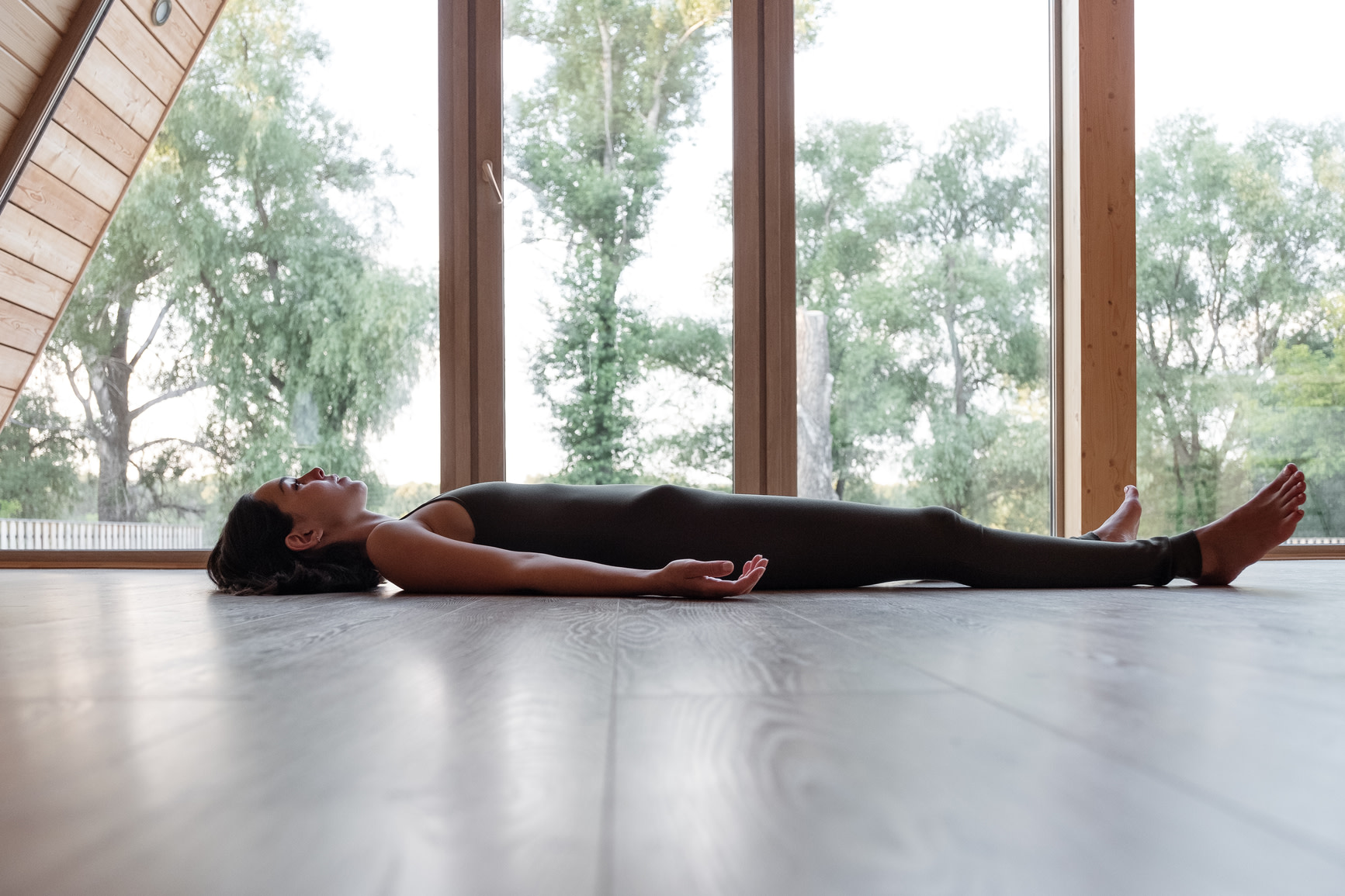What Is Savasana?
Physical and Mental Benefits of Savasana
Common Challenges with Savasana
4 Savasana Modifications to Try
Starting Your Savasana Practice
The Takeaway
Each yoga class is so different—from the type of yoga to the instructors’ style to the musical choices to the areas of focus—that you might be hard-pressed to think of one common factor in all of them. And yet almost every yoga class has one section that’s consistently the same: Savasana, commonly known as Corpse Pose.
This restorative yoga pose, in which you lie flat on your back for several minutes, is equal parts relaxing and tempting to skip if you’re cramming in a yoga session during a busy day. But however simple it may seem, Savasana Pose shouldn’t be overlooked as a crucial part of your yoga practice. Here, we’ll cover what Savasana is, the pose’s benefits, how to do it correctly, and several Savasana variations that can fit into your practice.
What Is Savasana?
Savasana, a Sanskrit word pronounced sha-va-san-a, is a restorative yoga pose that typically marks the end of your practice, whether you’ve just completed a vinyasa flow or a Yin Yoga class. Savasana's meaning breaks down into two parts: "sava" or "shava," translating to corpse, and "asana," translating to pose or posture. Here’s what else to know about Savasana.

How to Do Savasana
Yes, Savasana may look like you’re just lying on the ground, but there’s still an art to perfecting your form on the mat.
Lie flat on your back with your arms and legs extended.
Position your palms up to receive energy from the universe (which may be ideal for a morning yoga practice), or place your palms facedown to feel more grounded and relaxed.
Keeping your eyes gently closed, inhale and exhale in a slow, controlled pattern. Allow your thoughts to float by without sticking.
To exit Savasana, gently exhale and roll onto one side, supporting your head with your bottom arm and bending your knees up into a roughly 45-degree angle.
Pause for a breath or two. Then, press your hands against the floor to return to a seated position.
Physical and Mental Benefits of Savasana
Chances are, asking you to lie on the ground in a dark, quiet room isn’t a tough sell (who couldn't use a little more downtime?). But there are legitimate benefits to practicing Savasana regularly. Here’s what you get from Savasana that makes it a worthy part of your practice.
Deactivates the Nervous System
According to research in the International Journal of Yoga, Savasana encourages pratyahara, defined as a “turning inward of the senses.” By blocking out external stimuli during this pose, your nervous system gets a chance to relax and reset.
“Within the stillness of the body in Savasana, the central nervous system shifts toward down-regulation, the parasympathetic nervous system. This creates a sense of calmness, which helps the body to relax and restore,” explains Peloton instructor Kirra Michel. “A longer Savasana can allow this to fully take place in the body. It also can assist practitioners into finding a deeper meditative mind state, or at least drop some of the constant mind chatter.”
Improves Sleep
What goes hand-in-hand with a relaxed nervous system? Better sleep. The same research in the International Journal of Yoga notes restorative yoga, including Savasana, can be seen as an alternative therapy for insomnia.
Reduces Stress and Improves Mood
Feeling overwhelmed or a little down? A few minutes in Savasana may help reduce your stress. A small study in India measured participants’ moods and stress levels before and after a Savasana meditation technique. The results: Participants who completed the Savasana meditation reported significantly better moods and less depression than participants in the control group.
Improves Physiological Health
Studies have linked the practice of yoga—including Savasana—with several physiological health benefits. For example, a systematic review in the International Journal of Ayurvedic and Herbel Medicine notes that a yoga practice can lower glucose levels, improve cardiovascular health, regulate blood pressure, and lower cholesterol levels.
Common Challenges with Savasana
In our rise-and-grind culture, not everyone appreciates the opportunity to just lie still for a few minutes. Almost anyone who’s ever attended an in-studio yoga class knows the distraction of a fellow student getting up to scoot out of class early. That’s a missed opportunity, says Kirra. “I find that the people who tend to skip Savasana usually need it the most,” she says. “A lot of the time, it's the busy bodies who have trouble being still. Stillness can be the medicine to burnout and stress. I believe you are missing out on the sweetest part of the practice when you skip Savasana.”
What Should You Do If You Struggle to Stay Still in Savasana?
If you have a tough time being still in body and mind during Savasana, try these tips:
Cover your eyes with an eye mask, or even the sleeve of a sweatshirt. The weight and darkness will help you ignore external stimuli, and your eyes will feel fully relaxed.
Try a guided meditation or trusted mindfulness exercise to build mind-body awareness.
Repeat a mantra to yourself, like “I am worthy” or “Inhale the good, exhale the bad.”
Try a yoga class on the Peloton App
4 Savasana Modifications to Try
Still struggling with Savasana? You may not be in a comfortable position for your body. Making a few key modifications or using props can make the pose much more enjoyable.
Legs Up the Wall Pose
Placing your legs above the rest of your body (specifically, your heart) in an inversion improves your circulation, making legs up the wall pose a great addition to your recovery yoga flow. Don’t want to plant your feet on a wall? A chair can work as a substitute, with your calves resting on the seat and your knees bent at a 90-degree angle.
Sit sideways against a wall. You may choose to have some props nearby, like a blanket or bolster.
As you rotate to lie on your back, swing your legs up the wall. If you’re using a prop, it should be a few inches away from the wall and centered beneath you.
Remain in this Savasana variation for at least 10 minutes.
Savasana with Knee Support
If you deal with low back pain, hip pain, or knee pain, this simple Savasana hack can help make the pose infinitely more comfortable.
Sit on a mat with your legs extended.
Place a rolled up blanket, bolster, or pillow underneath your knees.
Lie back to enter Savasana and remain in the pose for at least 10 minutes.
Savasana with Neck Support
Similarly, neck pain can make Savasana feel uncomfortable. A simple blanket can give you the support you need. This is also an important Savasana modification for pregnant people, who should elevate the head and chest on a bolster to avoid putting additional stress on the heart.
Sit on your mat with legs extended and a blanket, bolster, or pillow nearby.
As you lie back, place the support at the base of your head and neck. Your forehead should be slightly higher than your chin.
Remain in Savasana for at least 10 minutes.
Savasana with Internal Rotation
In your natural Savasana alignment, your legs are probably externally rotated (think: your toes are rotated outward, with your heels closer to the midline of your body). Adding an internal rotation can be a refreshing Savasana variation.
Using a yoga strap, bathrobe belt, or resistance band, make one small loop.
Sit on the floor with legs fully extended and knees slightly bent.
Slide the loop over both of your big toes. Your heels should rotate toward.
Lie back to enter Savasana pose and remain here for at least 10 minutes. Continue to hold the yoga strap in one hand.
Starting Your Savasana Practice
Adding Savasana to your yoga practice is simple: You can (and should) tack it onto any and every yoga class you take. The key is being patient and holding the asana long enough to fully reap the benefits. In fact, if you have an extra five, 10, or even 15 minutes, you should stay in Savasana for that length of time.
If you’ve never tried doing an extended Savasana, Kirra has a suggestion. “At first, if you’re a busy body, the thought of Savasana, or meditation in general, might sound excruciating and impossible,” she says. “Give it time. Notice the resistance, relax the body, and do it anyway.”
It’s kind of like getting back into fitness after a break, Kirra adds. “You know that once you get back into routine, you start to enjoy it again and it may even become your favorite part of practice! That's how it was for me,” she says.
The Takeaway
Straightforward as Savasana might seem, it’s challenging in its own unique way. If you can commit to the stillness and accept the slight discomfort of not moving every minute of every day, you’ll likely find yourself feeling happier, less stressed, and more tuned into your body.
Read more
Want to strengthen your yoga practice?
We can help. Enter your email to get articles, instructor tips, and updates from Peloton sent to your inbox.







